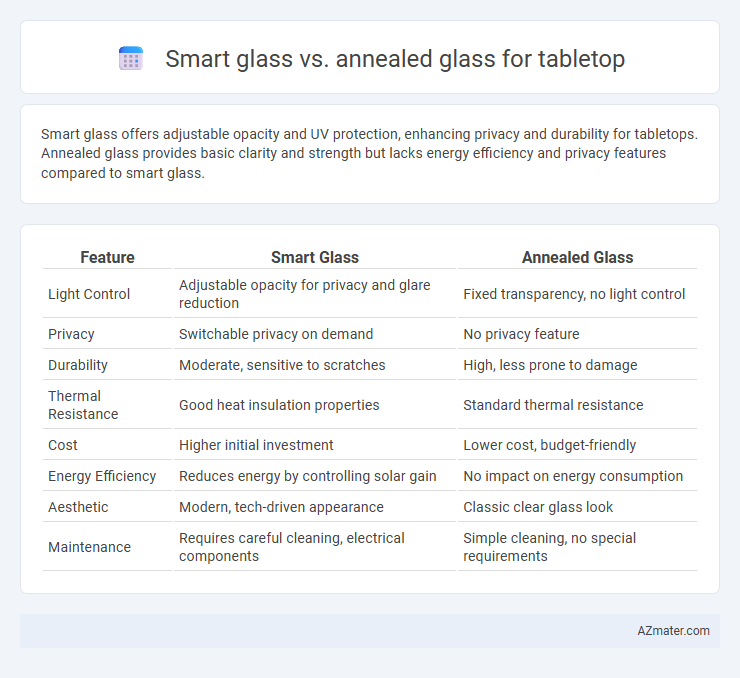Smart glass offers adjustable opacity and UV protection, enhancing privacy and durability for tabletops. Annealed glass provides basic clarity and strength but lacks energy efficiency and privacy features compared to smart glass.
Table of Comparison
| Feature | Smart Glass | Annealed Glass |
|---|---|---|
| Light Control | Adjustable opacity for privacy and glare reduction | Fixed transparency, no light control |
| Privacy | Switchable privacy on demand | No privacy feature |
| Durability | Moderate, sensitive to scratches | High, less prone to damage |
| Thermal Resistance | Good heat insulation properties | Standard thermal resistance |
| Cost | Higher initial investment | Lower cost, budget-friendly |
| Energy Efficiency | Reduces energy by controlling solar gain | No impact on energy consumption |
| Aesthetic | Modern, tech-driven appearance | Classic clear glass look |
| Maintenance | Requires careful cleaning, electrical components | Simple cleaning, no special requirements |
Introduction to Smart Glass and Annealed Glass
Smart glass incorporates advanced technology that adjusts transparency and light transmission through electric current, enhancing privacy and energy efficiency for tabletops. Annealed glass, a traditional type of glass cooled slowly to relieve internal stresses, offers clarity and strength but lacks the dynamic features of smart glass. Choosing between smart glass and annealed glass impacts aesthetics, functionality, and user experience in tabletop applications.
Composition and Manufacturing Process
Smart glass for tabletops is typically composed of laminated glass with embedded liquid crystal or electrochromic films that allow light modulation, manufactured through a complex lamination process involving multiple layers sealed under heat and pressure. Annealed glass consists of soda-lime silica glass cooled slowly to relieve internal stresses, produced through a controlled annealing process that enhances clarity and strength but lacks dynamic light control. The lamination and advanced film integration in smart glass result in customizable opacity and privacy features, whereas annealed glass provides consistent transparency with fundamental mechanical durability.
Visual Appearance and Design Options
Smart glass offers dynamic transparency control, allowing users to switch between clear and frosted states, enhancing both privacy and modern aesthetics for tabletops. Annealed glass provides a classic, fully transparent appearance with maximum clarity, ideal for showcasing intricate table designs or decorative items beneath. Design options with smart glass include customizable opacity levels and embedded patterns, whereas annealed glass is limited to fixed transparency and can be easily tempered or laminated for added safety.
Strength and Durability Comparison
Smart glass offers enhanced strength and durability compared to annealed glass, as it typically incorporates laminated or tempered layers that increase resistance to impact and breakage. Annealed glass, while cost-effective, is more prone to shattering into sharp shards upon impact, compromising safety and longevity in tabletop use. The advanced construction of smart glass ensures better performance under stress and prolonged durability, making it a superior choice for high-traffic or heavily used surfaces.
Safety Features and Impact Resistance
Smart glass offers superior safety features compared to annealed glass, as it can instantly switch from transparent to opaque, providing privacy and reducing glare. Its laminated construction ensures higher impact resistance, preventing shattering into sharp shards upon impact. Annealed glass lacks this durability, posing a greater risk of breakage and injury in tabletop applications.
Light Control and Privacy Capabilities
Smart glass offers dynamic light control by adjusting transparency levels to block or permit light, enhancing privacy on tabletops without sacrificing natural illumination. Annealed glass provides consistent light transmission but lacks the ability to alter transparency, resulting in minimal privacy control. For environments requiring adaptable privacy and customizable light filtering, smart glass outperforms annealed glass in tabletop applications.
Energy Efficiency and UV Protection
Smart glass offers superior energy efficiency for tabletops by dynamically adjusting its tint to reduce heat transfer and glare, significantly lowering cooling costs. Annealed glass, while providing basic UV protection by filtering some ultraviolet rays, lacks the adaptive properties needed to optimize energy savings throughout the day. The advanced technology in smart glass ensures enhanced UV blocking capabilities, contributing to prolonged furniture preservation and improved indoor comfort.
Maintenance and Cleaning Requirements
Smart glass tabletops require specialized cleaning agents to avoid damaging the electrochromic or switchable film, as abrasive cleaners or harsh chemicals can impair functionality. Annealed glass is more tolerant of regular glass cleaners and standard wiping techniques but is prone to scratches and chips that may increase cleaning difficulty over time. Both types benefit from routine dusting and gentle cleaning to maintain clarity and surface integrity.
Cost Analysis: Smart Glass vs Annealed Glass
Smart glass for tabletops typically costs between $50 and $150 per square foot, reflecting its advanced technology and energy-efficient properties, whereas annealed glass ranges from $25 to $50 per square foot, offering a more budget-friendly option with basic clarity and strength. Installation and maintenance expenses for smart glass may be higher due to the need for electrical components and specialized handling, while annealed glass involves lower installation costs and simpler upkeep. Long-term energy savings with smart glass can offset its initial premium, making cost analysis crucial when balancing upfront investment against functional benefits.
Best Applications for Tabletop Use
Smart glass is ideal for tabletops in environments requiring privacy control and dynamic light management, such as conference rooms and high-end restaurants. Annealed glass is best suited for decorative tabletops and casual settings where cost-effectiveness and ease of customization are priorities. For applications demanding safety and enhanced durability, tempered or laminated glass alternatives typically outperform both smart and annealed glass.

Infographic: Smart glass vs Annealed glass for Tabletop
 azmater.com
azmater.com